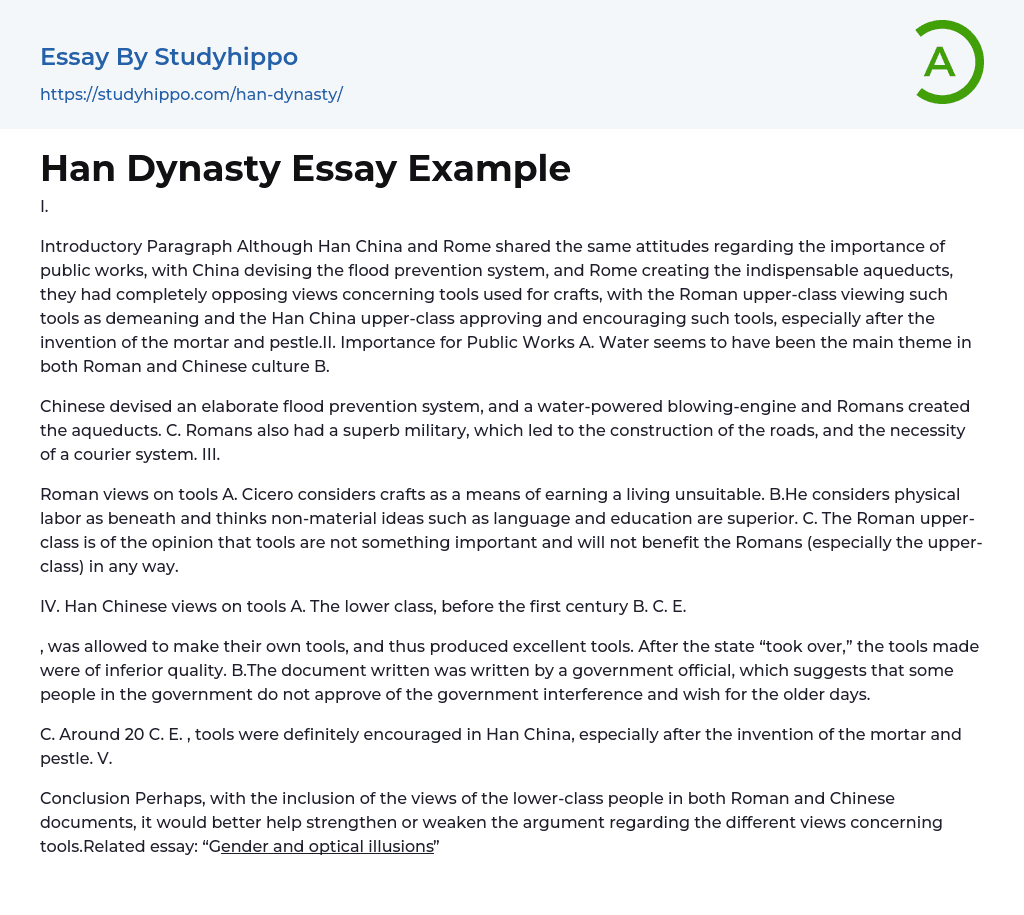I.
In the introductory paragraph, it is highlighted that while Han China and Rome shared a common view on the significance of public works, with China inventing a flood prevention system and Rome constructing essential aqueducts, their views differed greatly on craft tools. The upper-class in Rome considered these tools to be beneath them, whereas their counterparts in Han China approved and promoted their use, particularly with the introduction of the mortar and pestle. The significance of water was a prevalent feature in both societies.
Chinese engineers developed an intricate flood prevention system and a water-driven blowing engine, while the Romans boasted impressive military prowess that enabled them to build roads and establish a courier system. Furthermore, the Romans were known for their aqueducts.
According to Roman beliefs, tools are not highly valued or beneficial, as expressed by Cice
...ro who views crafts as an unsuitable means of earning a living. Physical labor is considered lowly in comparison to non-material concepts like language and education, which are deemed superior. This opinion is shared by the upper-class who do not place emphasis on the importance of tools for the benefit of Romans, particularly those of higher social status.
IV. Tools from the perspective of the Han Chinese:
A. The lower class's perspective before the first century B.C.E.
During the time when individuals were permitted to create their own equipment, they crafted exceptional items. However, after the government assumed control, the quality of the tools deteriorated. The fact that a government official wrote the document implies that there are some individuals within the government who disapprove of the intervention and yearn for the days of greater autonomy.
During the Han dynasty in China, around
20 C.E., there was a significant promotion of tools, particularly after the creation of the mortar and pestle.
To potentially reinforce or refute the argument on divergent perspectives regarding tools, it might be advantageous to incorporate the opinions of lower-class individuals from Roman and Chinese records. For further reading on this topic, see "Gender and Optical Illusions" at https://studyhippo.com/women-during-the-tang-dynasty/.
- Ancient Rome essays
- Augustus essays
- Byzantine Empire essays
- Julius Caesar essays
- Roman Republic essays
- Mark Antony essays
- Bangladesh essays
- China essays
- Hong Kong essays
- India essays
- Japan essays
- Kuala Lumpur essays
- Malaysia essays
- Manila essays
- Pakistan essays
- Philippines essays
- Singapore essays
- Vietnam essays
- Vietnamese essays
- Cuban Missile Crisis essays
- Fidel Castro essays
- French Revolution essays
- Han Dynasty essays
- Hiroshima essays
- Imperialism essays
- Jack The Ripper essays
- Mao Zedong essays
- Middle Ages essays
- Mongols essays
- Nelson Mandela essays
- Ottoman Empire essays
- Reformation essays
- Reign of Terror essays
- Renaissance essays
- Roaring Twenties essays
- Romanticism essays
- Samurai essays
- Scientific Revolution essays
- Soviet Union essays
- 1920S essays
- 1950S essays
- 1960S essays
- 19Th Century essays
- 20Th Century essays
- Ancient Greece essays
- Bravery essays
- British Empire essays
- Civilization essays
- Colonialism essays
- Declaration of Independence essays




